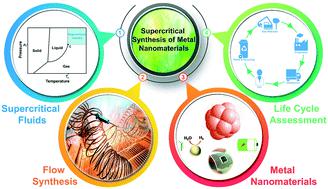当前位置:
X-MOL 学术
›
React. Chem. Eng.
›
论文详情
Our official English website, www.x-mol.net, welcomes your feedback! (Note: you will need to create a separate account there.)
Chemistry in supercritical fluids for the synthesis of metal nanomaterials
Reaction Chemistry & Engineering ( IF 3.9 ) Pub Date : 2019-09-02 , DOI: 10.1039/c9re00290a Yu Xu 1, 2, 3, 4 , Valentina Musumeci 1, 2, 3, 4 , Cyril Aymonier 1, 2, 3, 4
Reaction Chemistry & Engineering ( IF 3.9 ) Pub Date : 2019-09-02 , DOI: 10.1039/c9re00290a Yu Xu 1, 2, 3, 4 , Valentina Musumeci 1, 2, 3, 4 , Cyril Aymonier 1, 2, 3, 4
Affiliation

|
Metal nanomaterials are playing an increasingly important role in addressing challenges in modern society with respect to energy, catalysis, environment, information and so on. To maximize their performances in different application fields, fine control of their characteristics such as size and size distribution, morphology, composition, structure and surface properties is required. Suitable selection of the synthesis method for metal nanomaterials to achieve such control thus becomes rather important. In addition, the intent to use metal nanomaterials at a large scale puts extra expectations on the synthesis method that should be able to produce metal nanomaterials with high efficiency. Supercritical fluid synthesis of metal nanomaterials appears as a promising way to meet such needs thanks to the unique synthesis environment that speeds up the process but keeps the high controllability and reproducibility. In particular, supercritical fluid synthesis in flows enables continuous synthesis of metal nanomaterials and has high potential to be adapted into an industrial-level production process. This review focuses exclusively on the application of supercritical fluids in the synthesis of non-supported metal nanomaterials in both batch and flow reactors. Advancements in understanding the chemistry processes observed in the synthesis including thermolysis and reductive reactions in various types of fluids under their supercritical conditions are discussed and reviewed, with special attention to identifying the relationship between the properties of metal nanomaterials and the process parameters. Further, the versatility of the chemistry proceeding in supercritical fluids is shown by a few more examples on the synthesis of nanomaterials for applications in cutting edge technologies such as semiconductor nanocrystals, quantum dots, graphenic nanomaterials and metal–organic frameworks. Scaling up the supercritical fluid continuous flow synthesis to levels of pilot plants and even a full industrial plant has been achieved. The latest results and industrial progress in this area are discussed. Given this progress, the evaluation of the environmental impacts of the supercritical fluid flow synthesis becomes rather important. Finally, life cycle assessment (LCA) analysis is introduced as a powerful tool to evaluate the sustainability of chemical synthesis in supercritical fluids, shown by a few examples.
中文翻译:

超临界流体中用于合成金属纳米材料的化学
金属纳米材料在应对现代社会在能源,催化,环境,信息等方面的挑战方面发挥着越来越重要的作用。为了使它们在不同应用领域中的性能最大化,需要对其特性(例如尺寸和尺寸分布,形态,组成,结构和表面特性)进行精细控制。为金属的合成方法的适当选择的纳米材料,以实现这样的控制因而变得相当重要。另外,大规模使用金属纳米材料的意图对应该能够高效生产金属纳米材料的合成方法提出了额外的期望。金属纳米材料的超临界流体合成似乎是满足此类需求的一种有前途的方法,这要归功于独特的合成环境,该合成环境可加快过程,但保持高可控制性和可重复性。特别地,流动中的超临界流体合成使得能够连续合成金属纳米材料,并且具有适用于工业水平生产工艺的高潜力。这篇综述专门针对间歇反应器和流式反应器中超临界流体在无载体金属纳米材料合成中的应用。讨论并回顾了理解合成中观察到的化学过程的进展,包括在超临界条件下各种类型流体中的热解和还原反应,特别要注意识别金属纳米材料的性能与工艺参数之间的关系。此外,更多的关于纳米材料合成的例子展示了化学在超临界流体中进行的多功能性,这些纳米材料可用于前沿技术,例如半导体纳米晶体,量子点,石墨烯纳米材料和金属有机骨架。已经实现了将超临界流体连续流合成规模扩大到中试工厂甚至整个工业工厂的水平。讨论了该领域的最新成果和产业进展。有了这一进展,对超临界流体流动合成的环境影响进行评估就变得非常重要。最后,
更新日期:2019-09-02
中文翻译:

超临界流体中用于合成金属纳米材料的化学
金属纳米材料在应对现代社会在能源,催化,环境,信息等方面的挑战方面发挥着越来越重要的作用。为了使它们在不同应用领域中的性能最大化,需要对其特性(例如尺寸和尺寸分布,形态,组成,结构和表面特性)进行精细控制。为金属的合成方法的适当选择的纳米材料,以实现这样的控制因而变得相当重要。另外,大规模使用金属纳米材料的意图对应该能够高效生产金属纳米材料的合成方法提出了额外的期望。金属纳米材料的超临界流体合成似乎是满足此类需求的一种有前途的方法,这要归功于独特的合成环境,该合成环境可加快过程,但保持高可控制性和可重复性。特别地,流动中的超临界流体合成使得能够连续合成金属纳米材料,并且具有适用于工业水平生产工艺的高潜力。这篇综述专门针对间歇反应器和流式反应器中超临界流体在无载体金属纳米材料合成中的应用。讨论并回顾了理解合成中观察到的化学过程的进展,包括在超临界条件下各种类型流体中的热解和还原反应,特别要注意识别金属纳米材料的性能与工艺参数之间的关系。此外,更多的关于纳米材料合成的例子展示了化学在超临界流体中进行的多功能性,这些纳米材料可用于前沿技术,例如半导体纳米晶体,量子点,石墨烯纳米材料和金属有机骨架。已经实现了将超临界流体连续流合成规模扩大到中试工厂甚至整个工业工厂的水平。讨论了该领域的最新成果和产业进展。有了这一进展,对超临界流体流动合成的环境影响进行评估就变得非常重要。最后,


























 京公网安备 11010802027423号
京公网安备 11010802027423号